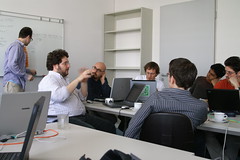Ginseng is a natural language query facility for RDF. The inspiration is “fridge poetry for the Semantic Web.” (a great tagline!)
“The markup prisoner’s dilemma” – why should I do markup if there are no tools making use of it, and why should I build tools when there is no markup?
“People do not understand formal logic. Full stop.” And they don’t even understand simple boolean logic.
So how should users do queries? Possible answers are query by example, graphical query languages, or full natural language processing. In practice, none of these really work for the semantic web.
Ginseng lets users query an RDF dataset with a limited form of natural language. They demo it with a geographical dataset. The text input field has autocompletion, so when you start with “W”, it will offer “What”, ”Where” and so on. If you type “Where is the m” it will offer “mississipi” and a bunch of other locations.
The dataset must have good terms or it won’t work well. Ginseng defines an RDF property for adding synonyms. So if your term is geo:isMountainOf, you could add a synonym “lies in” to the dataset.
Ginseng has a simple question grammar. It is combined with terms from the dataset into a full grammar that specifies all possible questions.
Queries are translated into a bunch of SPARQL queries that are executed against the dataset.
They did an informal user evaluation. People did reasonably well, but they didn’t like it because it restricts what they are allowed to type.
They intend to put it out as open source “after we clean it up.”
This is cool because you could potentailly point it at any SPARQL endpoint anywhere on the web and it would just work. (Well, somewhat, because most datasets don’t have good terms or synonyms.)



